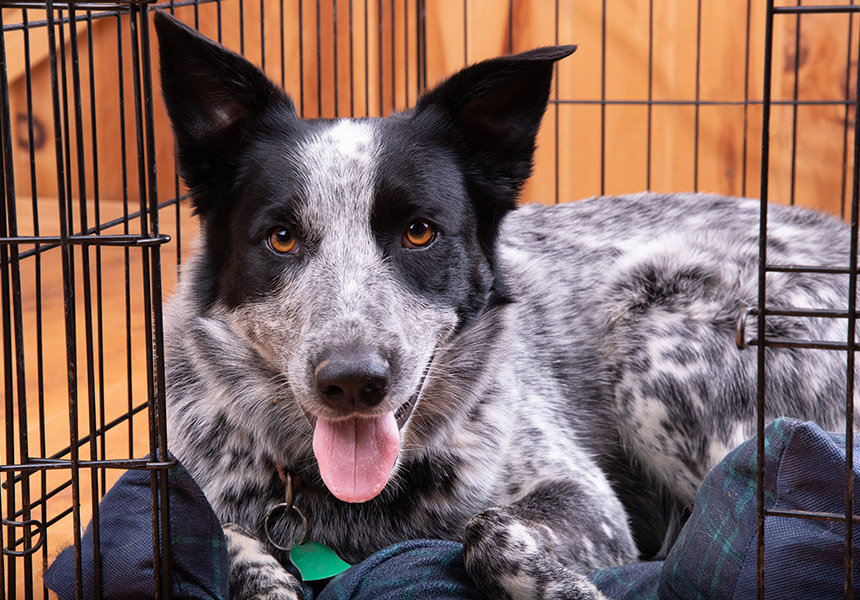
Crate Training a Dog
Crate training is an important part of bringing a new dog into your household. From keeping your pup from soiling your home to giving them a comfortable space,
Some people may see crate training as abuse, but— when used properly— a crate is an excellent tool to calm anxiety and keep your dog from hurting themself. If your dog is taught through positive reinforcement to love their crate, the crate can become the perfect place for solitude when a dog is tired or nervous.
Caution Before Your Crate
Just like with any training, a crate has to be used correctly to be effective. If not used correctly, you can actually do more harm than good to your pup. Some things to avoid include:
- Using the crate as a punishment. This will only teach your dog to fear the crate, creating a situation where they may refuse to enter it.
- Crating for too long. Puppies under six months of age should not be left in their crates for longer than 3-4 hours at a time. They can’t control their bladders in the same way adult dogs can.
- Crating and not playing. A dog that’s crated all day and into the night doesn’t get enough exercise or human interaction— resulting in a depressed and anxious dog that might cause even more destruction. If your dog is crated for too long, try changing your schedule, hiring a dog walker, or taking your dog to daycare for that much-needed interaction.
Types of Crates
There are several types of crates available and it can take some work to figure out what kind of crate works best for your dog. Crates are typically made of plastic, fabric on a collapsible frame, or collapsible metal pens. They can come in a variety of sizes and purchased through your local pet store.
Your dog’s crate should be just large enough for them to stand up and turn around in. For puppies that are still growing, you can purchase a crate that will accommodate their adult size and just block off the excess room until it’s needed.
Crate Training a Puppy
Crate training a puppy can be a long process— but definitely worth it in the end. Because puppies can’t hold their bladders as easily as an older dog, make sure you’re scheduling in plenty of potty breaks throughout the day.
Choose a quiet spot in your home away from high-traffic areas to place your new puppy’s crate. Make sure the crate is out of direct sunlight and away from heat sources (including in-floor heating!) to keep your puppy from overheating while inside. By choosing a cool— but not cold— and quiet spot, your puppy’s crate will start to feel like a “home away from home”!
Also, make sure your puppy isn’t wearing a harness or collar while inside the crate. Harnesses, collars, and ID tags that dangle present a strangulation risk. They can easily get caught in between crate doors and the bars.
Crate Training an Anxious Dog
Just as some people experience anxiety, dogs experience anxiety, too! If your dog is distressed when you’re not home they may have separation anxiety. There can be dangerous consequences for your dog if a dog with separation anxiety is not properly contained.
For crate training an anxious dog, try keeping them in their crate for short bursts of time at first. Try just a few minutes with you standing close by. From there, you can progress to leaving the house for short periods of time. With new technologies like Furbo, Alexa, and nanny cams, you can check in to see how your pup is doing during these short periods without actually having to physically be there.
Crate Training at Night
Crate training at night can help with your potty training efforts. Being in the crate overnight will force your puppy to restrain themself and use the bathroom at the right time. The trick, however, is to make sure you wake up before the puppy has to wake you up.
Be patient and consistent— no letting your little fur friend sleep in your bed while you’re crate training— and your puppy will learn what you expect in no time!
Crate Training an Older Dog
Crate training an older dog can be a difficult and frustrating process if you’re not prepared. Whether it’s retraining your dog to love their crate or starting from scratch, it’s important to stay patient and keep calm during the training.
Whereas puppies aren’t used to a set routine yet and everything is new and exciting, older dogs have a routine they’ve been following and are creatures of habit. You’ll have to take the time to unlearn old habits in order to form new ones.
Give your dog some exercise before a crate training session. It’ll help your dog burn off some energy and relieve themself so distractions will be limited. You can even try feeding your dog in the crate to start getting them more comfortable being inside.
Crate Training Schedule
Having a consistent schedule is an important aspect of crate training. Even us, as humans, need a schedule. You get up, you go to work, you eat lunch, you come home, make dinner, shower, and go to bed probably around the same time every day. Your dog wants that same security.
If you’re not sure what kind of schedule your puppy will need, try talking with a dog trainer! Our team of expert dog trainers has years of experience helping owners like you crate train your dog. Give us a call today at 513-252-9019 or by filling out our contact request form.
